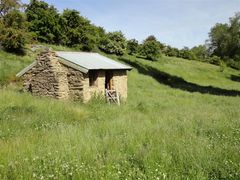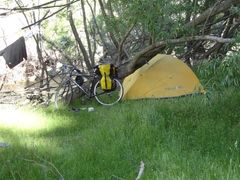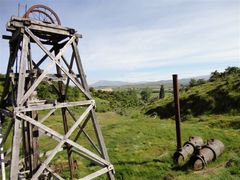The Otago Central Rail Trail

The rail trail is one of New Zealand's great bike rides. The route is based on the old railway that once looped around the great plain of the Maniototo. No traffic, no hills to speak of, three (dark) tunnels and a number of great trestle bridges and stone cuttings. This trail takes approximately three days and follows through some of Otago's best and least populated country.
The views are outstanding and the night sky, unpolluted by street lights, gives a fresh intensity to stars, satellites, meteors and planets. Geographically, this area was formed by the floor of a prehistoric sea, and you still get that awed sense of walking in an ancient cathedral when you step out into this landscape.
Middlemarch
Occasionally a tourist train comes in from Dunedin and drops cyclists off, but this is the end of the line. What is left of the rails and sleepers is stacked at Sutton, a few kilometres south. From Middlemarch the bedded gravel trail is devoted to pedestrians, cyclists, sheep and the occasional horse. There are several gates which may require opening and relatching, but the way is generally uninterrupted all the way to Clyde a further 150-ish km away (pick up a rail trail brochure from the local store).
Middlemarch appears to have closed its old campground (Blind Billy's) although locals assure me that there is free camping on the local Domain with limited facilities, but this is something I would check before I put up my tent. There are however a number of backpackers and coffee bars. A good idea for cycle campers is to arrive by train and spend an hour in Middlemarch having food or sight-seeing, and then cycle the 30 kms to Hyde (no store, but an interesting old cemetery).

Although you can camp (boutique accommodation and coffee bar) at Hyde, I suggest a lovely spot is the DOC camp at Tiroiti (Daisybank) 7 kms further on through the tunnel and beyond. There is legal camping on flat ground next to a narrow, fast-river running through a shallow ravine lined with willows. You can swim too, if you are cautious and pick your site carefully. Evening here brings the rabbits and the faint twilight and stillness that make the trail magical. Highly recommended.
Leave a little late and enjoy cycling in the cool afternoon and early evening. An Otago summer day is often the hottest in the country, but the sun sets late and you can easily cycle to Daisybank without running out of daylight.
A word on tunnels. They are neither lit nor straight. While only a few hundred metres long they can appear quite grim. Take out your torch and walk or cycle carefully using lights. By the time you get to the third tunnel you will be quite blasé about them. You can make Middlemarch to Ranfurly easily in a day if you wish (59 kms), but remember the surface is not sealed and the gravel, while fairly even for the most part, limits you to around 8 - 10 kph with panniers.
Ranfurly

Ranfurly is a good sized town and has everything you need for a night's rest. Store, backpackers, pub, campground and restaurant. It has an interesting tourist display which focuses on the history of the now absent railway, but altogether the town is a bit dull. When I passed through I found the banking facilities very limited for a largish town and the coffee bar did not take Visa... a bit odd. The people are friendly enough but you get the feel the place needs a bit of energy and imagination.
From here the rail trail becomes even more interesting. More bridges, tunnels and wide landscape views of mountains and plains and glimpses of isolated gold trails stretching into the brown hills. This is wonderful semi-desert country. Hot and still in summer, it freezes in winter.
The rocks are a mixture of schist and granite and are formed into odd and often grotesque shapes by ice and freezing winter winds. The miners built their huts of schist, splitting it off and creating drystone walls that still form barns and sheep enclosures for local farmers.
Ranfurly is only 40 km or so from St Bathans and fifteen from Naseby, two old gold towns that have survived the decline of gold to become small, sleepy settlements.
Wedderburn
Wedderburn (great sod brick pub with meals available, no store) has a new addition, The Red Shed. This is a campground with good facilities on the hill next to the trail with fine views. It has chalets and backpacker rooms as well. The Shed is unattended but provides a large area with displays and shelter and a coffee machine.
Although not generally noticeable, the rail trail runs slightly uphill to this point and downhill, mostly, from this point on. Being a railway, the inclines are so gradual as to not be overly onerous.
Oturehua

Oturehua is a good place to stop for an ice cream or coffee. It has most facilities (a pub/store/tearoom and camping at the local Backpacker) plus the addition of a fantastic coffee bar just out of town called The Ida Valley Kitchen. The township has the old General Store and the Hayes Engineering Works as attractions, but one of the great free side trips are the remains of The Golden Progress mining site just before you reach the township (signposted). This is a pleasant walk into the dry hills past old cottages, tailings, the remnants of rusting boilers and gold-seeking industries including a 'poppet head' mine with an impressive wooden tower constructed over a 45 metre shaft.
Camping in the local Domain is allowed apparently, but it pays to ask the locals, politely, first. Oturehua has an interesting local museum based on the history of engineering in the area. After passing through two tunnels and over a massive and impressive trestle bridge, you arrive at Lauder (coffee bar, pub and accommodation/backpackers. No camping that I could see and no store but meals at the pub).
You can stop here or head the odd 10 km further on to Omakau (pub, store, tearooms, Backpackers). I generally stop here because of a small hamlet called Ophir.
Ophir
Ophir is off the main trail, about 2 km down a side road from Omakau heading east. This beautiful hamlet maintains that old gold mine town charm. There are no shops but at the time of writing an elaborate coffee bar was being constructed out of the old General Store. Pub meals and basic accommodation are available at Flannery's Backpackers/camping just off the main street. Further on out of town is a beautiful example of 19th century suspension bridge. Barely a hundred metres across it is nonetheless quite lovely in its quiet surroundings of river and trees.
Look out for fish sunning themselves in the warm shallows. This place is so relaxing you might want to spend days here. There are numerous small side trips to other old gold towns including Matakanui or you might just fossick around the dry, tussocky hills and streams and wonder at the remains of tiny, isolated stone huts and the stamina and dreams of the miners who built them.
It is an easy day past Chatto's Creek (great pub) with the trail winding down past paddocks of Bugloss flowers (used for honey manufacture) to Alexandra, a large town with a couple of bike shops, camping grounds and Backpackers. Alexandra is a place to catch up on movies or broken spokes, e-mail or whatever.
Alexandra
Alexandra is a pleasant town full of old pubs and the odd historic building. Sadly little remains of the great suspension bridge that once crossed the Clutha River at this point, but the stone pillars remain to give you an idea of the endeavour of engineers in what must have been one of the globe's more inaccessible places in the late nineteenth century. From Alexandra you can cycle easily into Clyde eight or so kilometres further on and celebrate journey's end. Better still, the trail is extending as I write toward Roxburgh, not exclusively along old railway lines, but through rolling countryside that is occasionally more challenging to cycle but no less beautiful.